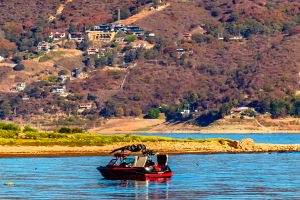
Jet Ski Adventures

Jet skis have become an increasingly popular form of water entertainment, captivating enthusiasts with their speed and manoeuvrability.
However, this surge in popularity has also raised safety concerns, particularly the risk of capsizing.
Understanding why jet skis capsize, how to prevent such incidents, and knowing the appropriate response can enhance safety for all riders. This comprehensive article delves into these critical aspects.
Causes of Jet Ski Capsizing
1. Improper Operation
One of the primary reasons for jet ski capsizing is improper operation. Novice riders, in particular, are prone to making mistakes due to their lack of experience.
Errors during acceleration, turning, or braking can easily lead to a loss of balance. For instance, attempting a sharp turn at high speeds can generate substantial centrifugal force, causing the jet ski to tip over.
Related
 Flowing Waters Through Millennia: Unveiling the Wisdom of Terraced Irrigation
Flowing Waters Through Millennia: Unveiling the Wisdom of Terraced Irrigation
 Blue fireworks, a dazzling yet hazardous marvel, require precise chemistry for their stunning effect.
Blue fireworks, a dazzling yet hazardous marvel, require precise chemistry for their stunning effect.
 Explore the mysteries behind lakes' captivating blue hues: from light dynamics to microbial influence, unraveling nature's artistry.
Explore the mysteries behind lakes' captivating blue hues: from light dynamics to microbial influence, unraveling nature's artistry.
 Unravel the ballet of airplane takeoff, a symphony of precision and innovation in aeronautical engineering.
Unravel the ballet of airplane takeoff, a symphony of precision and innovation in aeronautical engineering.
 Roadside trees offer environmental, ecological, and aesthetic benefits, underscoring their importance in urban development.
Roadside trees offer environmental, ecological, and aesthetic benefits, underscoring their importance in urban development.
 Despite weighing thousands of tons, ships float due to buoyancy, smart design, and advanced materials.
Despite weighing thousands of tons, ships float due to buoyancy, smart design, and advanced materials.
Additionally, incorrect weight distribution on the jet ski can significantly increase the risk of capsizing. Uneven weight distribution between the driver and any passengers can destabilize the craft, making it prone to flipping.
2. Adverse Weather Conditions
Adverse weather conditions are another significant factor contributing to jet ski capsizes. High winds and rough waves make it challenging to control and maintain balance on a jet ski, particularly at higher speeds.
Large waves can quickly destabilize the craft, leading to a capsize. Therefore, understanding and respecting weather conditions is crucial for safe jet ski operations.
3. Equipment Failure
Although less common, equipment failure can also result in a jet ski capsizing. Malfunctions in the steering system or engine can cause the rider to lose control, potentially leading to an accident.
Regular maintenance and thorough inspection of the jet ski are essential to prevent such incidents. Ensuring all components function correctly before each ride can significantly reduce the risk of equipment-related capsizes.

How to Prevent Jet Ski Capsizing
1. Learn and Comply with Safe Operating Practices
Professional training is fundamental in minimizing the risk of capsizing. Novice riders should undergo formal training to learn essential skills such as proper acceleration, deceleration, turning, and emergency handling.
Consistent adherence to these practices is crucial. Furthermore, wearing a life jacket is a mandatory safety measure for drivers and passengers, providing essential buoyancy in an accident.
2. Pay Attention to the Weather Forecast
Always check the weather forecast before heading out on a jet ski. Avoiding adverse weather conditions is critical, even for experienced riders. High winds and waves can drastically increase the likelihood of capsizing.
If weather conditions deteriorate while you are on the water, you should return to shore immediately or seek a safe area.
3. Regular Maintenance and Inspection of Equipment
Regular maintenance and inspections on your jet ski are vital for ensuring its safe operation. Before each ride, check the steering, engine, fuel, and other critical components to identify potential issues.
If you are unsure about the condition of your jet ski, seek the assistance of a professional for a detailed inspection and necessary repairs.
Conclusion
Jet skis offer exhilarating fun and excitement, but they also come with inherent risks, including the possibility of capsizing. Prioritizing safety ensures that the thrill of jet skiing can be enjoyed without unnecessary accidents, allowing for a more enjoyable and secure experience on the water.